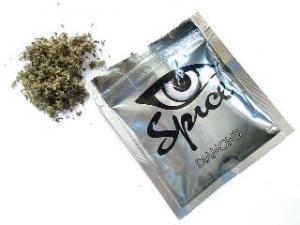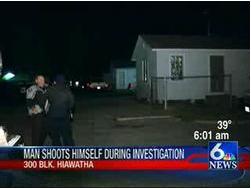A new designer drug is generating the same old knee-jerk prohibitionist responses. Be scared, very scared!
Who could have foreseen this? Laws designed to limit illicit meth production by tracking cold pill purchased have led to a whole new black market, the AP reports.
DrugWarFacts.org, a publication of Common Sense for Drug Policy, is an in-depth compilation of key facts, stats and quotes on the full range of drug policy issues, excerpted from expert publications on the subjects. The Chronicle is running a series of info items from DrugWarFacts.org over the next several weeks, and we encourage you to check it out.
A campus cop, an auxiliary cop, and a sheriff's deputy all go down.
New year, new body count in Mexico's seemingly unending prohibition-related violence. It's up to 136 so far this year.
Despite a nationwide emergency ban by the DEA, some state legislators still feel impelled to ban synthetic cannabinoids at the state level.
One Nebraska state senator has identified a grave threat to the Cornhusker State: Welfare recipients on drugs.
The Illinois House has shot down a medical marijuana bill already passed by the state Senate, but there is an outside chance it could still get another shot this session.
The year's second death during a drug law enforcement operation occurred Tuesday in Corpus Christi. Police said it was a suicide, but some local observers are assuming the worst.
Events and quotes of note from this week's drug policy events of years past.
Poison control centers, hospital emergency rooms, and law enforcement are all raising the alarm about a new, uncontrolled stimulant drug, and the first moves to ban the drug at the state level have already taken place. But the DEA has yet to act, and drug policy analysts say that a reflexive move to ban the drug may not be the answer.

Going, going, gone in Louisiana. Who's next?
The drug is 4-methylmethcathinone, also known as mephedrone, a synthetic derivative of cathinone, the psychoactive stimulant found in the khat plant. (To be completely accurate, there are actually a number of methcathinone analogues involved, but for brevity's sake we will refer simply to mephedrone.) It produces a stimulant effect that users have likened to that of cocaine, ecstasy, methamphetamines, or Ritalin.
The drug is being sold as bath salts, plant food, or plant fertilizer and typically marketed with the words "not for human consumption" under product names including Ivory Wave, Vanilla Sky, Pure Ivory, and Sextacy. Marketers also use names with a local charge, such as Hurricane Charlie in Louisiana and White Lightning in Kentucky.
After hysterical press coverage of unproven mephedrone overdose deaths in England early last year, the drug was banned in the United Kingdom, and in November,
the European Union banned mephedrone in member countries, citing a
risk assessment from the
European Monitoring Center on Drugs and Drug Abuse (EMCDDA).
But while that risk assessment found that mephedrone can cause acute health problems and lead to dependence, it found only tenuous links between mephedrone and any alleged fatalities. The risk assessment also cautioned that banning the drug could create its own problems. "Control measures could create an illegal market in mephedrone with the associated risk of criminal activity," EMCDDA warned.
But the European Union didn't listen, and now, politicians in the US states where mephedrone is most prevalent, are jumping on the ban bandwagon. Last week, Louisiana Gov. Bobby Jindal (R) issued an
emergency rule making the possession, distribution, or manufacture of mephedrone illegal and placing it in Schedule 1 of the state's controlled substances act. That means violators could face up to 30 years in prison.
"These drugs have crept into our communities and they are hurting our kids," said Jindal as he announced the rule. "We have to do everything in our power to protect our children and to make sure our streets are safe for our families. The reality is that the chemicals used to make these dangerous substances have no legitimate use other than to provide a high for the user. Today’s announcement gives our law enforcement officials the tools they need to crack down on the people pushing these dangerous drugs. Indeed, our law enforcement officials can immediately take these drugs off the shelf -- and at the same time, it's now illegal to possess and use these dangerous chemicals."
This week, neighboring Mississippi is moving against the substance. At least
two bills to ban mephedrone have been introduced and are moving through committees. The bills are likely to be combined. As in Louisiana, the bills envision harsh penalties, with offenders facing up to 20 years in prison.
News media reports warning of the new "menace" and urging authorities to act have also appeared in
Georgia and
Texas. Such news reports are often a precursor to legislative or administrative action.
That these first moves to ban mephedrone are taking place on the Gulf Coast makes sense because that is where the drug has made the deepest inroads. Louisiana Poison Control Center director Dr. Mark Ryan went public with news of mounting calls about mephedrone just before Christmas, and on Monday, the American Association of Poison Control Centers issued a
nationwide alert about mephedrone.
The alert shows that, at this point, mephedrone is very much a regional phenomenon. Poison control centers around the country have taken more than 300 calls about mephedrone, 69 of them in just the first days of 2011. While poison centers representing 25 states have received calls, 165 of them were in Louisiana. Kentucky was second with 23 calls. In the Upper Midwest, however, there have been no calls about mephedrone.
"We got notice a few weeks ago about reports from other poison centers, but we're not aware of any coming to our regional center," said Rachel Brandt of the Sanford Poison Control Center in Sioux Falls, South Dakota, which covers Minnesota and the Dakotas.
It's a much different story in Louisiana. "We got our first case on September 29 and shortly thereafter we began getting calls just about every day," said the Louisiana Poison Control Center's Dr. Ryan. "We reported to the state health department that this was coming up on our radar, that we were getting people with bizarre, off-the-wall symptoms, with some of them staying in the hospital for five to seven days and the symptoms not resolving very well. The state became very concerned, and so did we as the number of calls continued to increase."
According to Dr. Ryan, adverse responses to mephedrone can be extreme. "We are seeing people describing intense cravings even though they don't like the high," he said. "We're seeing guys discharged from the hospital showing up again a few days later. We're seeing people who are very anxious or suffering from extreme paranoia, we're seeing people with suicidal thoughts, we're seeing people with delusions and hallucinations. A common thread is that they describe monsters, aliens, or demons."
But while the adverse reactions can be disturbing, and while three deaths have been "linked" to mephedrone, there have been no verified mephedrone overdose fatalities. In one case, a 21-year-old man named
Dickie Sanders committed suicide three days after ingesting mephedrone. Louisiana media also referred to two other deaths "linked" to the substance, but the connection to mephedrone use remains unproven.
"They're saying the other two are related, but there is no toxicology to back that up," said Dr. Ryan.
Dealing with new designer drugs is difficult and frustrating, Dr. Ryan said. "We banned six different substances after looking at the ones abused in European countries," he said. "But you can't ban everything, and you could make a different designer cathinone every day. It's like a cat chasing its tail."
The DEA is also taking a look at mephedrone. But unlike state legislators, which can act without the least bit of evidence, the DEA is charged with actually finding good reasons to add a new drug to the list of proscribed or controlled substances. While more than a dozen states have criminalized the psychedelic salvia divinorum based on little more than the fear someone somewhere might get high on something legally, the DEA has had salvia on its radar as a drug of concern for nearly a decade, but has yet to find the evidence it needs to schedule it. On the other hand, the DEA is susceptible to political pressure, as indicated by its
quick action last November to ban synthetic cannabinoids after being asked to do so by Sen. Orrin Hatch (R-Utah).
Mephedrone has been on the DEA's radar since at least September 2009, when an analysis of drug samples containing mephedrone was published in the agency's
Microgram Bulletin. But a DEA spokesman told the Chronicle this week the agency has yet to act.
"This is a drug of concern," said DEA public information officer Michael Sanders. "We're looking into it right now. We see those drugs out there, but there is a lot of research that goes into actually scheduling something."
The DEA may be well served by not rushing to judgment, said drug policy analyst Bill Piper, national affairs director for the
Drug Policy Alliance. Prohibiting drugs has not worked in the past and there is no reason to assume it will now, he argued.
"Regulation is pretty much always better than prohibition because it means you can actually control the drug," he said. "You can regulate potency, quality, and all that stuff, but prohibiting it just drives it further into an unregulated market. Prohibition certainly has not controlled cocaine, ecstasy, or meth," Piper pointed out.
"It seems really strange that the political position around drugs in this country is that the only drugs people can legally use from now until the end of time are apparently alcohol, tobacco, and caffeine," Piper said. "And at least two of those substances are more dangerous than most of the other drugs. Every new substance is either banned immediately or eventually. This should be something for policymakers and voters to discuss and debate instead of just having knee-jerk responses."
That unfortunately has yet to happen, for mephedrone or for most drugs, and the drive to prohibit mephedrone is gaining steam.
back to top
The Associated Press is still on a roll. We reported last week on the AP's "occasional series" on the failures of drug prohibition, and now the news organization is out with another devastating piece of reporting, this time on the unintended consequences of laws designed to stifle home methamphetamine manufacture.

Smurf alert! anti-meth laws create new black market
In a Monday "AP IMPACT" article (not part of the "occasional series) titled
Meth Flourishes Despite Tracking Laws, AP reported that state laws mandating electronic monitoring systems to track purchases of legal cold medicines containing pseudoephedrine that are used in meth manufacture "not only failed to curb the meth trade," but "also created a vast and highly lucrative market for profiteers to buy over-the-counter pills and sell them to meth producers at a huge markup."
Because of booming demand created in large part by the tracking laws, pill buyers can buy a box of pills for $7 or $8 and resell them for $40 to $50. That has created whole networks of people who "smurf," or make repeated small purchases of the cold pills and then sell them to meth cooks. Some are not even interested in meth, but can be homeless people looking for a few bucks or even college kids seeking weekend beer money.
"It's almost like a sub-criminal culture," DEA agent Gary Boggs told the AP. "You'll see them with a GPS unit set up in a van with a list of every single pharmacy or retail outlet. They'll spend the entire week going store to store and buy to the limit."
The electronic monitoring laws "invite more people into the criminal activity because the black market price of the product becomes so much more profitable," said rural Missouri detective Jason Grellner. "Where else can you make a 750% profit in 45 minutes?" asked Grellner, former president of the Missouri Narcotics Officers Association.
Looking at DEA data from 2000 to 2009, the AP found that the number of meth busts has started climbing again since tracking laws were enacted beginning in 2006. Meth-related activity, including arrests, drug seizures, and the discovery of abandoned meth cooking sites, was up 34% in 2009, the news organization found. In the three states -- Arkansas, Kentucky, and Oklahoma -- that have electronically tracked cold pill sales since 2008, the 2009 increase was nearly double the national increase, at 67%.
The report also found that while the tracking laws had a strong initial impact, meth producers quickly turned to smurfing to obtain the pseudoephedrine they needed. By 2009, the DEA reported 10,064 meth-related incidents, a 62% rise over the previous two years.
The AP did note that Oregon, which began requiring a prescription for pseudoephedrine products in 2006, had seemingly been successful in repressing meth cooking. It had 191 meth-related incidents in 2005 and only 12 in 2009. But that law has left hundreds of thousands of law-abiding consumers suffering because of the actions of a few.
back to top
DrugWarFacts.org, a publication of Common Sense for Drug Policy (CSDP), is an in-depth compilation of key facts, stats and quotes on the full range of drug policy issues, excerpted from expert publications on the subjects. The Chronicle is running a series of info items from DrugWarFacts.org over the next several weeks, and we encourage you to check it out.
Did you know that 23 states' prison systems are operating at over 100% capacity?
"The increases in drug imprisonment, the decrease in releases from prison, and the re-incarceration for technical parole violations are leading to significant overcrowding and contribute to the growing costs of prisons. Prisons are stretched beyond capacity, creating dangerous and unconstitutional conditions which often result in costly lawsuits. In 2006, 40 out of 50 states were at 90 percent capacity or more, with 23 of those states operating at over 100 percent capacity."
(Justice Policy Institute, "Pruning Prisons: How Cutting Corrections Can Save Money and Protect Public Safety," May 2009, via the DrugWarFacts.org Prisons and Drug Offenders chapter.)
Follow Drug War Chronicle for more important facts from DrugWarFacts.org over the next several weeks, or sign up for the DWF new facts RSS feed.
Common Sense for Drug Policy is a nonprofit 501(c)(3) organization dedicated to reforming drug policy and expanding harm reduction. CSDP disseminates factual information and comments on existing laws, policies and practices.

back to top
A campus cop, an auxiliary cop, and a sheriff's deputy all go down. Let's get to it:

evidence room of opportunity
In Somerset, Ohio,
a Somerset auxiliary police officer was indicted Monday for allegedly trafficking "bulk" amounts of oxycodone to southeastern Ohio. Joseph Michael Daley, 33, is accused of traveling to Florida and bringing the drugs back to Ohio for resale. He went down in a sting in December. He is charged with aggravated drug trafficking and is out on bond pending trial.
In Tallahassee, Florida,
a former Florida A&M University (FAMU) police officer pleaded guilty Monday to buying and reselling marijuana and lying to the feds about it. Former FAMU patrol officer Byron Whitaker, 32, acknowledged buying pot from a local dealer for sale in Tallahassee and even negotiating a purchase while he was on duty in his patrol car. During a DEA interview last August, Whitaker falsely told agents he had not bought drugs from the supplier. He pleaded guilty to federal charges of conspiracy to distribute marijuana and making false statements to a federal agent. He faces up to five years in prison on each count.
In Madison, Wisconsin,
a former Marquette County deputy sheriff pleaded guilty January 6 to stealing drugs from a locked evidence room. Daniel Card was busted for taking 59 oxycodone tablets from the evidence room in May 2007. He had already been found guilty of drug possession following a jury trial in 2009. He pleaded guilty to theft this time around. Sentencing is set for March 23.
back to top
by Bernd Debusmann, Jr.
Mexican drug trafficking organizations make billions each year smuggling drugs into the United States, profiting enormously from the prohibitionist drug policies of the US government. Since Mexican president Felipe Calderon took office in December 2006 and called the armed forces into the fight against the so-called cartels, prohibition-related violence has killed more than 30,000 people, including more than 13,000 last year. The increasing militarization of the drug war and the arrest of dozens of high-profile drug traffickers have failed to stem the flow of drugs -- or the violence -- whatsoever. The Merida initiative, which provides $1.4 billion over three years for the US to assist the Mexican government with training, equipment and intelligence, has so far failed to make a difference. Here are a few of the latest developments in Mexico's drug war:
Thursday, January 6
In Ciudad Juarez,
ten people were murdered across the city. At least two houses were burned down by heavily armed gunmen, including at least one in which they shot and killed a victim just before. In another incident, three people were shot dead.
In the nearby town of Guadalupe, at least one person was executed and several houses were burned down. The town has been without any sort of law enforcement or firefighters since the last police officer was kidnapped in December. She remains missing.
Friday, January 7
In Coahuila,
the body of the missing Zaragoza mayor was found in neighboring Nuevo Leon. Mayor Saul Vera Ribera had been missing since Wednesday after taking a trip to the state capitol of Saltillo. He had apparently been shot in the head.
Saturday, January 8
In Acapulco,
15 decapitated bodies were found on a sidewalk outside a shopping center. Two of the victims were 17 years old. A note left with the bodies suggests they were killed by members of the Sinaloa Cartel led by "El Chapo" Guzman. Handwritten posters left at the scene suggested that those killed had been extortionists in the employ of another cartel.
In another part of the city, six bodies were found stuffed in a taxicab. At least two other people were killed in separate incidents in the city. Additionally, ten people were kidnapped from a nightclub, three of whom were found dead the next day.
In Mexico City, four men were killed in a drive-by shooting. It is unclear whether this incident is related to narcotics trafficking.
In Ciudad Juarez,
at least ten people were killed. In one incident, police found three bound and gagged men executed in a vehicle near the highway. In another incident, two men were gunned down by gunmen wielding assault rifles.
Monday, January 10
In the Monterrey suburb of Guadalupe,
the local police department ordered its officers to remain in their stations. A similar order was issued by the Transit Police. This comes in the wake of violence on Friday which claimed the lives of four police officers and wounded three others. Police in the neighboring towns of San Nicolas, Apodaca and San Pedro are continuing patrols, but only in heavily armed convoys.
In Nuevo Leon,
a well-known Zeta commander was killed after being stabbed over 20 times in prison. Gabriel Ayala Romero was well-known for his involvement in distributing pirated goods, as well as drug trafficking and violence. He had been in prison since being captured by the army in June 2009.
Tuesday, January 11
In Ciudad Juarez,
it was revealed that the body of a woman found a few days previously was that of poet and social activist Susana Chavez. Susana had been outspoken in calling for justice in the countless unexplained femicides that have occurred in the city. Three men are in custody for the murder.
Total Body Count for the Year: 136
back to top
The reflexive response of state legislators to respond to new, uncontrolled substances by banning them continues unabated this year as bills to proscribe synthetic marijuana have been filed in Nebraska and Indiana. Another synthetic pot ban bill is pending in Connecticut, and Washington state bureaucrats acted at year's end to ban the substances there.

In the bull's eye at the state house (image via Wikimedia)
Sold under names like K2 and Spice, the products contain synthetic cannabinoids that produce psychoactive effects roughly similar to marijuana. While about a dozen states and numerous municipalities moved against synthetic cannabinoids last year, the substances remained unregulated at the federal level until
the DEA imposed an emergency ban that took effect on Christmas Eve.
But the federal ban has not deterred state legislators from acting since then. In Nebraska, Sen. Beau McCoy has introduced
LB 19, which would prohibit the possession or sale of synthetic cannabinoids. That bill has been referred to the Judiciary Committee, where a hearing has been set for January 19.
In Indiana, state Sen. Joe Zakas (R-Granger) introduced
SB 152, which bans synthetic cannabinoids and punishes use or distribution with the same penalties in place for marijuana. That legislation passed the Senate Corrections Committee unanimously on Tuesday.
In Connecticut, no bill has been formally introduced yet, but several legislators, parents, and members of the anti-drug abuse group
Connecticut Prevention Network met Monday to call for legislation there. Rep. Patricia Wilditz (D-Guilford) said the substances are becoming increasingly popular among young people and that the public needed to be warned of their dangers.
In Washington state, meanwhile, the compounds were
banned by action of the State Board of Pharmacy on December 30. The ban there came three weeks after a Seattle man struck three pedestrians with his vehicle and later claimed to have been under their influence.
"The chemicals are very potent synthetic cannabinoids and can cause harm when used, generally by smoking," the Board of Pharmacy said. "These are effects that can affect behavior, judgments and health."
Reported
adverse effects of synthetic cannabinoids include panic attacks, anxiety, agitation, rapid heartbeat, vomiting, hallucinations, tremors, and seizures. No fatal overdoses have been reported.
back to top
Under a bill introduced Monday by state Sen. Charlie Janssen (Fremont-Nonpartisan), Nebraska residents applying for or receiving welfare benefits could be subject to drug testing and the loss of their benefits if they test positive.

Charlie Janssen
The bill,
LB 221, would direct the state Department of Health and Human Services to develop a program to screen welfare applicants or recipients for the presence of controlled substances if the department has "reasonable cause" to think they may be using drugs. "Reasonable cause" is not defined.
If applicants or recipients test positive, they are entitled to an administrative hearing to determine whether the drug test is accurate. If the drug test result is deemed accurate at the hearing, the department "shall declare the applicant or recipient ineligible for such cash benefits for a period of one year from the date of such a determination." The person would also be referred to a drug treatment program.
Bills requiring welfare recipients or recipients of unemployment benefits to be subject to drug testing are
a perennial favorite with pseudo-populist politicians, but in recent years have all gone nowhere. One reason is the cost of drug testing thousands or tens of thousands of people; another is because of their questionable constitutionality. The only welfare drug testing bill to pass in recent years was a 1998 bill in Michigan, but that bill was never implemented before being
ruled unconstitutional by a US appeals court in 2003.
Janssen rose to national prominence as an advocate of tough local anti-illegal immigration laws in Fremont, Nebraska.
back to top
Lawmakers in Springfield Thursday voted to reject a bill that would have allowed some Illinois patients access to medical marijuana. The bill, SB 1381, was defeated in the House by a vote of 56-60.

There is no joy in Springfield... (image via Wikimedia)
The measure had passed the state Senate on a 30-28 vote in May, meaning that passage by the House would have sent the measure to the desk of Gov. Pat Quinn (D) and made Illinois the 16
th medical marijuana state once he signed it.
The bill would have given patients suffering from chronic, debilitating medical conditions, such as cancer, multiple sclerosis, or glaucoma, the right to possess up to two ounces for their own use. It would also have allowed them or designated caregivers to grow up to six plants, three of which could be flowering. That number was lowered from seven during consideration by the Senate.
The House sponsor of the bill, Rep. Lou Lang (D-Skokie) had pressed for a vote on the bill this week, saying it would pass if all supporters showed up. They didn't, but undaunted by the defeat, Lang told
St. Louis Today he planned to reintroduce the bill.
"I am going to continue to press on -- on this particular piece of legislation, or some version of it -- until I pass it," Lang said. "Next year, the year after... I'm a young man. I'll be here awhile."
There is still an outside chance the bill could be passed this session. As the
Marijuana Policy Project noted in a Friday email to supporters, a representative who voted no on the bill can file for a motion of reconsideration to bring the bill up for another vote. One has already done so, the group reported.
back to top
Editor's Note: This year, Drug War Chronicle is going to try to track every death directly attributable to drug law enforcement this year. We didn't have to wait long, did we? We covered the year's first drug war death last week. We can use your help. If you come across a news account of a killing related to drug law enforcement, please send us an email at [email protected].]
The year's second death during a drug law enforcement operation occurred Tuesday night in Corpus Christi, Texas, where
police said an as yet unidentified man shot himself to death as they searched a house suspected of drug activity. The dead man was identified only as a 20-year-old Hispanic male "deceased from a possible gunshot wound."
According to the Corpus Christi Police account, patrol officers investigating drug activity at the address received permission from one of the inhabitants to enter the house and search. As an officer entered a bedroom, he heard a single gunshot from a closet or bathroom. The officer found seven men and one woman in the bedroom and ushered them out, but another shot was heard as they left, as well as a male voice yelling he had a hostage. The officer attempted to talk to the man, but heard only a third gunshot.
A SWAT team was called in and surrounded the house, but attempts to negotiate with the man inside were met with silence. SWAT officers then entered the residence and found the dead man, the police report said.
There was no word on any drug arrests and no mention of any evidence seized, other than a handgun police said was found beside the dead man's body. They said it was stolen. The seven people detained by police were released back to the same address.
The death did not sit well with someone in the community. Police returned to the same address early Wednesday morning to find the
house covered with anti-police graffiti. One message called police murderers, while another referred to them with an expletive. Graffiti visible in a photo shown by a local TV news station said "You take ours, we take yours" and "We love you, homie."
Corpus Christi Police said Wednesday some of the messages seemed to be a direct threat. "We take this very seriously and we will be following up on that," said Lt. G. Ermis.
back to top
January 16, 1919: The 18th Amendment (alcohol prohibition) is declared ratified and is scheduled to take effect in one year.
January 16, 1920: At midnight, the 18th Amendment becomes law, making alcohol illegal.
January 12, 1929: The Porter Narcotic Farm Act is passed, establishing the first two narcotics hospitals for addicts in federal prisons in response to addicts' crowding.
January 14, 1937: A private federal cannabis conference takes place in room 81 of the Treasury Building in Washington, DC, leading to enactment of federal marijuana prohibition later that year.
January 15, 1963: President Kennedy establishes the Advisory Commission on Narcotic and Drug Abuse, with Judge E. Barrett Prettyman as chair.
January 16, 1980: Paul McCartney is arrested by Japanese customs officials at Tokyo International Airport when they find two plastic bags in his suitcases containing 219 grams of marijuana (approximately 7.7 ounces). Concerned that McCartney would be refused a US visa under immigration laws if convicted and be unable to perform in an upcoming Wings concert in the US, Sen. Edward Kennedy calls first secretary of the British Embassy D.W.F. Warren-Knott on January 19. McCartney is released and deported on January 25.
January 18, 1990: Mayor Marion Barry of Washington, DC, is arrested after hidden cameras record him smoking crack cocaine with ex-girlfriend Hazel Diane "Rasheeda" Moore in her room at the Vista Hotel.
January 15, 1997: Milahhr Kemnah, an AIDS patient visiting the Cannabis Cultivators Club in San Francisco, becomes the first person to buy medical marijuana in California following passage of Proposition 215.
January 12, 2001: Salon.com reports that the nephew of Attorney General-designate John Ashcroft received probation after a felony conviction in state court for growing 60 marijuana plants with intent to distribute the drug in 1992. This is a lenient sentence, given that these charges often trigger much tougher federal penalties and jail time. Ashcroft was the tough-on-drugs Missouri governor at the time.
January 15, 2002: The Associated Press reports that a federal appeals court ruled that, in Idaho, marijuana users can drive legally as long as their driving isn't erratic and they can pass a field sobriety test. A three-judge panel of the San Francisco-based 9th US Circuit Court of Appeals wrote that while it is illegal to drive under the influence of alcohol or narcotics, Idaho law doesn't list marijuana as a narcotic.
January 14, 2003: A high profile pain prosecution ends with a whimper when California prosecutors dismiss all remaining charges against Dr. Frank Fisher.
back to top









